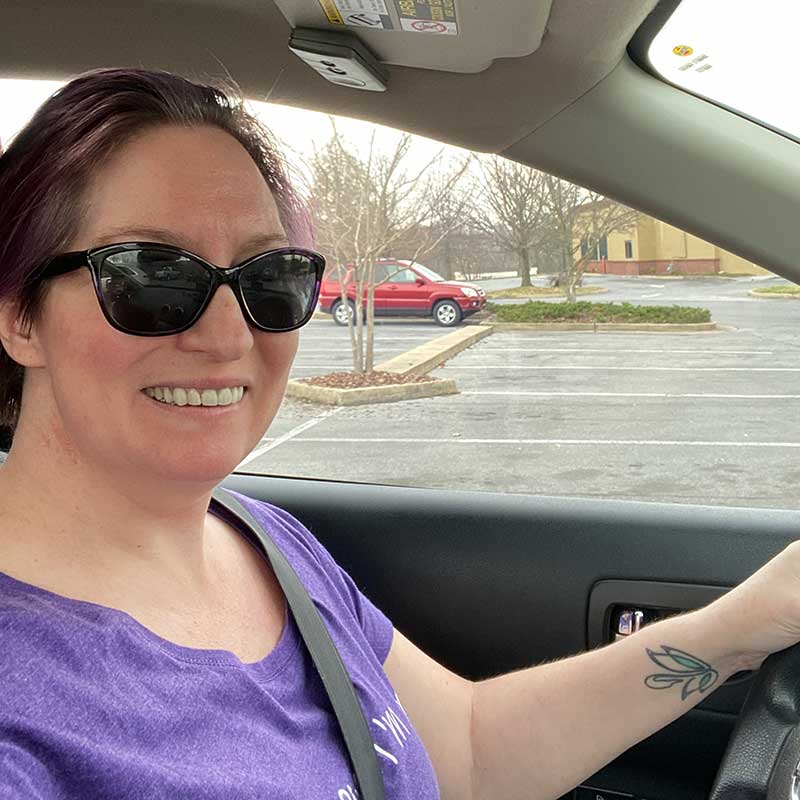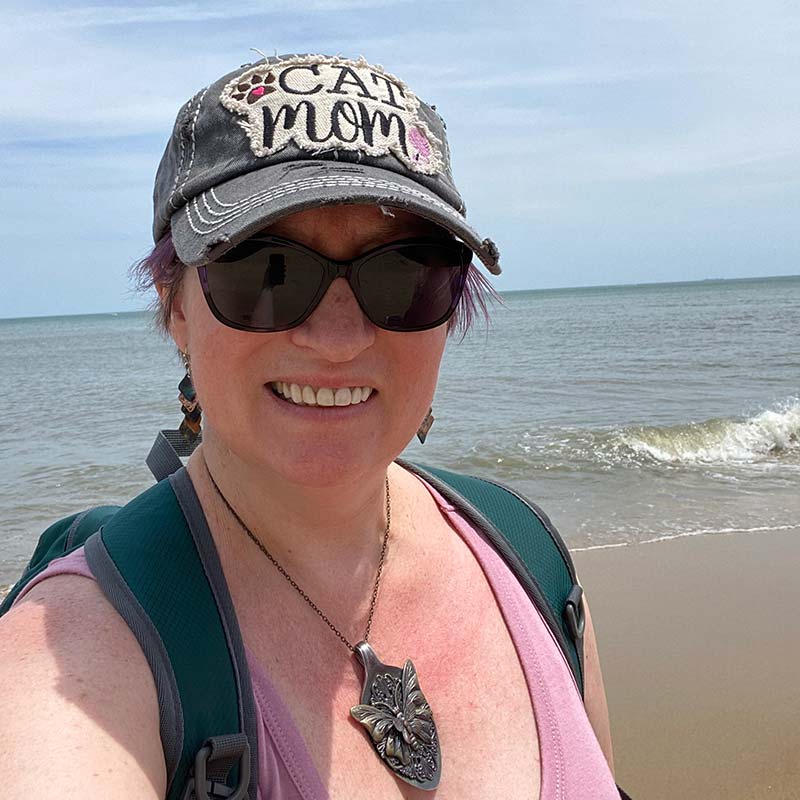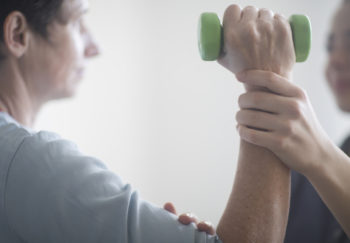Charity Fowler contributed this post. She had a rare type of ischemic stroke in September. She is an assistant professor in UVA’s English department.
It started with a migraine on a Thursday. Since I’ve suffered from migraines since I was 8, this wasn’t that concerning, in and of itself. I took my trusty migraine meds (Imitrex) and laid down. As usual, the Imitrex did its work. An hour or so later, I was ready to teach my classes for the day. By the evening, though, the migraine was back. More Imitrex, then bed.
This pattern repeated for the next four days. This, too, had happened before. But by Sunday, I’d decided that if the migraine hadn’t broken by Monday, I’d go to urgent care. They usually gave me a shot of something that broke the migraine.
Unable to Get Up
Things get a little fuzzy from there. What I do know is that eventually, I was stretched out on the sofa and reaching for a glass of water I’d set on my coffee table. I lost my balance and fell, hitting my head on the corner of the table.
When I tried to get up, I couldn’t. I tried more times than I could count, always falling, no matter what way I tried to get up. I usually hit something hard — the coffee table, the edge of the hearth, my grandfather’s coal bucket.
My phone was on the sofa, and I realized I needed help. After the repeated head blows, I was terribly dizzy and convinced I had a concussion. So, my goal shifted to just getting my phone, so I could call a friend to come help me get up and get me to urgent care. But my arms wouldn’t support me. All I needed was to push up onto my knees and I couldn’t.
Body Betrayal
I felt so betrayed by my body. I work out, I’m fit, but what use were all those push-ups and dips if I couldn’t even push up into a Cobra position, transfer to Downward-Facing Dog, and then up to reach my phone? (Yes, my mind was still trying to figure out any possible way to get off the floor. Yoga positions were a prime focus for maybe an hour). I could hold a plank for 3 minutes, but that day, I couldn’t even get into the position.
I was getting scared, but I didn’t start crying until the incontinence hit. Then, I didn’t even want to call a friend for help, because of the shame and embarrassment of wetting myself as a healthy 44-year-old. I didn’t even have the excuse of having gone through childbirth.
From there, my memory does cut out. I know the cats were upset. I cried a lot and was sure no one was ever going to find me. I’d die and the cats would eat me, and that’s how I’d be found, finally. (Apparently I fixated on this, as my mom says I kept repeating it over the next week.)
The Scariest Experience of my Life
Looking back, I’m terrified, and it was the scariest thing I have ever been through. Mom and I thought I was on the floor for almost 36 hours, but we’re not sure.
What I do know is that somehow, I finally managed to get my phone and apparently FaceTimed my mom, some 24-36 hours after I fell. I couldn’t figure out how to turn the phone to see her, but I was eventually able to get out, “I’ve fallen and hit my head, and I can’t get up.”
Even then, in the state I was in, I felt ridiculous, like I was quoting the original Lifeline commercials. Mom wanted me to call 911, but I didn’t think it was bad enough to involve the paramedics. Also, I didn’t want anyone to see me in the state I was on the floor. Thankfully, over my objections, Mom called. She stayed on the phone until they arrived.
They were kind and gentle, even as I was mortified for calling them for a mere concussion. Clearly they, and my mother, were thinking much better than I was.
Getting Help: The Ambulance and the ER
Once in the ambulance, I was curious, but my head hurt too badly to look around. I kept telling them I was pretty sure I had a concussion. They must’ve relayed that to the UVA emergency room, because after a dizzying ride and journey through well-lit halls (the lights were all I saw), I wound up in the CT machine. It was less than fun with my head still pounding, but better than the later MRI, with its deafening, teeth-reverberating booms.
Getting Answers: What Caused My Ischemic Stroke
The scans detected a clot in my brain and other evidence of an ischemic stroke. My entire care team in the ER was exceptionally kind. I was terrified when they said I was having a stroke and had a clot still in my brain. They were all calm and reassuring and explained things in a way that made sense even in my addled state. I wish I could remember everyone to thank them all personally – but at points I could barely remember my name, let alone learn new ones.
According to my medical records and insurance claims, Dr. Min Park performed an intra-arterial mechanical thrombectomy to remove the clot. I know this saved my life and my quality of life. Things moved fast, but I always felt like the people around me were more than up to the challenge I presented.
They were also kind, keeping me updated on things, both medically and personally. They let me know when they’d spoken to my mother and that she was on her way from east Tennessee. It’s almost a 5-hour drive from her home to Charlottesville, so I know I was in the ER and surgery around that long, because I had barely woken up in the neurosurgery intensive care unit when she was there.
The big question, then, became how and why had this happened? I was young and healthy – I eat right, I work out, I manage my stress in healthy ways. While I do have high blood pressure (it’s a family curse), it’s well-controlled with medication. There was no reason I should have had a stroke.
Right Brain Damage
We eventually discovered that I had a very rare form of a stroke. My carotid artery had spontaneously dissected, and the clot that formed to close that wound broke free and caused the stroke. We’ve never discovered what caused the dissection. It’s usually from some kind of trauma to the neck. While I had hit my head in my initial fall, my symptoms made it likely that the dissection happened earlier, and I fell because I was having a stroke.
The stroke had damaged the right side of my brain, which controls the left part of my body. Essentially, the damage made my brain forget I had a left side at all. I couldn’t get my body to cooperate because half of it wasn’t getting the message about what to do. Most of my recovery would involve retraining the brain to recognize the left side, then send it the right signals of what to do.
Stroke Recovery
My youth and health, at least, were on my side. My biggest takeaway from discussions that first day was that I was going to be okay and should recover 100%. That was enough in the moment, especially since it was several more days before that initial migraine actually broke and left for good. That might have kept me from really absorbing the weight of what had happened and mitigated the initial feelings of trauma.
The hospital allowed my mom to stay with me most of the day every day, so I wasn’t alone with time for the fear to really settle in. Then, fairly quickly, I focused on recovery. That recovery truly began at UVA Encompass inpatient rehabilitation, where I stayed for three weeks after the stroke. I made great progress there, but recovery hasn’t been easy, and I’m still not at 100%.
My New Body: Re-Learning Walking & (Simple) Workouts
After Encompass, I had home health services for a couple of weeks. Then I went back to Tennessee to stay with my parents and do outpatient therapy for a few months. I’ve finally learned to walk without a cane or a pronounced limp, except when tired. I can’t move very fast, yet, and I’m not very coordinated. I was a Zumba aficionado before the stroke, and I’m a long way from being able to move my feet that quickly and precisely.
But when I remember that I left Encompass 6 months ago heavily reliant on a walker just to stand, my lack of Zumba skills seems less important. I have started working out again regularly, though, and can do straightforward low-impact cardio routines with simpler foot patterns. That means no jumping jacks yet, as I get unsteady coming back down after both of my feet leave the ground.

Post-Stroke Fine Motor Challenges
My arm has had the hardest road. I’m able to use it a bit more now. I can grasp and carry items that aren’t too heavy and care for myself. But my fine motor skills are still severely lacking — I still can’t type with my left hand, for instance. Given I’m an English professor, teaching writing, this is a significant deficit. I’ve managed with adaptive technology like speech-to-text and gotten very proficient at typing with just my right hand, but I still feel the loss.
It’s still improving, though. Every day, I notice something I can do better or that I couldn’t at all before. It’s the strangest feeling to try simple things, like reach up to take off glasses, and your body simply doesn’t obey. I don’t feel like I really know my body anymore. I never know when it might just decide it’s done for the day, or when I might zone out and snap back to realize I’ve missed half of a TV episode. Things I can do fine one day really hurt the next, and it never, ever feels like I’ve had enough sleep.
Beyond the Physical: Working Through Stroke-Related Trauma
I’m living independently again, though that is still new and anxiety-producing as I write this post. I’m very happy to be back in my own home, which I purchased and moved into about a month before the stroke. I feel confident I can do what I need to do to take care of myself. For the few things I can’t — mostly heavy cleaning that requires multiple flights of stairs and changing sheets — I’ve been lucky enough to hire someone to help.
But it is here, on my own again, where I realize that while my physical recovery has come miles, I haven’t really faced my emotional recovery.
Thanks to the resources I received at UVA Encompass, I knew that depression and anxiety are common post-stroke. Initially, I focused on physical rehab. I was also mentally and emotionally adjusting to being back at work, albeit virtually. I was too busy and distracted to really feel the emotional after-effects.
But slowly, they’ve made themselves known. I get overwhelmed more easily, and I’m more likely to cry over things I might not have before. On the other hand, I have noticed a tendency to want to brush off what happened, to act like it was no big deal.
How I was Lucky
Because I’m so young and because I got help in time from doctors who recognized that I had more than a concussion, the consequences were less dire than they could have been. I have no cognitive or speech impairments, and my physical impairments lessen daily.

But this isn’t because a stroke — my stroke — is no big deal. I got lucky in being able to finally get to my phone. I got lucky in getting treatment before the clot in my brain did more significant damage. I got lucky in having physical and occupational therapists who pushed me from the start to take advantage of the brain’s optimal learning window post-stroke. This could have been so much worse.
Stroke Symptoms: Nobody is Too Young
I don’t know if it would have helped if I’d recognized my stroke symptoms, since my phone was out of reach. But muscles simply not working like they usually do, with weakness on one side of the body or the other, is a key symptom. Drooping of one side of the face and slurred speech are other signs of stroke, but they aren’t always ones you can identify yourself if you can’t get to a mirror or hear yourself. But the biggest thing I learned was that I was not immune because of my age or my health.
Strokes don’t only happen to people who are older or unhealthy. They can happen to anyone at anytime. I don’t know if knowing that could have helped me. Maybe I would’ve called 911 instead of my mother, or maybe I just would have been even more scared on that floor. But it’s not something I’ll ever forget.
My New Normal
On the good side, a stroke is life-threatening, but it doesn’t have to end your life. The brain has an amazing ability to heal itself after injury. My past 9 months have looked very different from what I expected. But I have also learned a lot about myself, about my capabilities, about my friends and my family.
I don’t know if I have any grand takeaways about life. I’m still trying to figure that out, to be honest, still sorting and processing. But I have a new perspective on what’s important to me and what I’m capable of. I’m working on putting other things into that perspective, to not dwell things that don’t matter in the grand scheme of life.
Stroke Symptoms?
Someone having a stroke may have numbness on one side of their face or body, difficulty speaking, or a sudden and severe headache. Call 911 right away.
Some of that’s hard while working through the psychological trauma, and I haven’t always done as well as I’d like.
But as I continue to work on my physical recovery and finally start my emotional recovery, too, these are things I’m realizing and perspectives I want to embrace in my new normal. Because even when I have fully recovered (and I will), I do know that I will never be the same. Ultimately, I want those changes to make my life better than before. I do know that I am more grateful to my care team at UVA Health and Encompass to have that chance than I can ever properly express.


Thank you for sharing your story. Such an important message! And your strength and attitude are an inspiration. I wish you well on your continued recovery.
Thank you for sharing your story and your encouragement to continue to heal and do what you have to do to get better. Best wishes on your continued recovery.
This is such an important story, one that we all need to hear and learn from so we can recognize the signs of stroke. Thank you for sharing it.
Good luck with your continuing recovery!
You are so strong. AND so articulate. I could feel every thing you described. Good luck w/ recovery!
Your message was right on target. I suffered a left brain stroke and am working to recover use of my right dominant hand. My gait also needs improvement. It has been difficult but with the help of family and friends it has been easier. Charity, we are on the same train. You are the first stroke patient that I “know” (through this article). I a retired high school science teacher. I will be cheering you along.